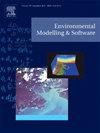基于数据融合的半干旱流域径流模拟研究
IF 4.8
2区 环境科学与生态学
Q1 COMPUTER SCIENCE, INTERDISCIPLINARY APPLICATIONS
引用次数: 0
摘要
准确的径流模拟对干旱半干旱区水资源管理至关重要。本研究提出了一种将机器学习(ML)与概念和基于物理的模型相结合的新方法,以解决伊朗半干旱的Jazmourian河流域传统模型的局限性。HBV和SWAT水文模型分别用于概念和物理模拟,而支持向量回归(SVR)和多层感知器(MLP)将水文模型输出与水文气象变量相结合。利用1963-1989年(干旱期)和1993-2019年(湿润期)两个时期的水文气候数据,研究评估了模型在对比条件下的性能。提出的“融合SVR”和“混合SVR与鲸鱼优化算法”(SVR- woa)模型在模拟径流峰值方面具有更高的准确性。SVR-WOA模型在1993-2019年和1963-1989年期间的性能分别比SWAT提高了26.17%和25.36%,RMSE值分别为9.90 m3/s和10.33 m3/s。这凸显了混合建模在应对各种水文挑战方面的潜力。本文章由计算机程序翻译,如有差异,请以英文原文为准。
A data fusion approach to enhancing runoff simulation in a semi-arid river basin
Accurate streamflow modeling is crucial for water resource management in dry and semi-arid regions. This study proposes a novel approach combining machine learning (ML) with conceptual and physically-based models to address of traditional model limitations in Iran's semi-arid Jazmourian River Basin. The HBV and SWAT hydrological models are used for conceptual and physically-based simulations, respectively, while Support vector regression (SVR) and multilayer perceptron (MLP) integrate hydrological model outputs with hydro-meteorological variables. Using hydroclimatic data from two periods-1963-1989 (dry phase) and 1993–2019 (wetter phase)-the study evaluates model performance under contrasting conditions. The proposed "fusion SVR" and "hybrid SVR with whale optimization algorithm" (SVR-WOA) models demonstrate improved accuracy in simulating runoff peaks. The SVR-WOA model achieves a 26.17 % performance improvement over SWAT for 1993–2019 and 25.36 % for 1963–1989, with RMSE values of 9.90 m3/s and 10.33 m3/s, respectively. This highlights hybrid modeling's potential for diverse hydrological challenges.
求助全文
通过发布文献求助,成功后即可免费获取论文全文。
去求助
来源期刊

Environmental Modelling & Software
工程技术-工程:环境
CiteScore
9.30
自引率
8.20%
发文量
241
审稿时长
60 days
期刊介绍:
Environmental Modelling & Software publishes contributions, in the form of research articles, reviews and short communications, on recent advances in environmental modelling and/or software. The aim is to improve our capacity to represent, understand, predict or manage the behaviour of environmental systems at all practical scales, and to communicate those improvements to a wide scientific and professional audience.
 求助内容:
求助内容: 应助结果提醒方式:
应助结果提醒方式:


